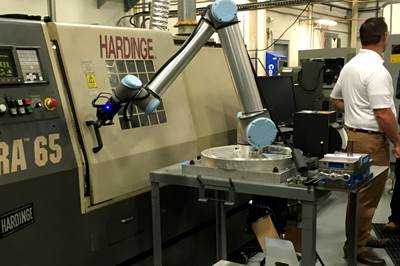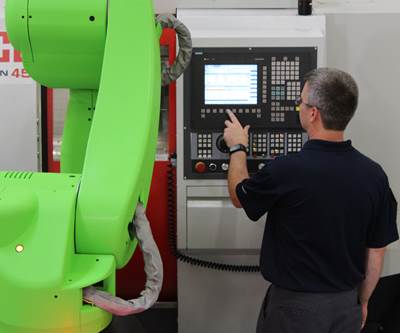5 Things to Consider Before Purchasing a Robot
Start simple, and you’ll be successful.
Share


.png;maxWidth=45)
DMG MORI - Cincinnati
Featured Content
View More

Autodesk, Inc.
Featured Content
View More


I might be dating myself a bit here, but back in the 1980s, there was a belief among machinists like myself that robots were for repetitive work. They were for big companies (with deep pockets) entrenched in automation and efficiency. We pictured car assembly plants with continuous streams of parts moving along an automated line, with robots painting, bonding and assembling different makes and models. The whole thing looked and sounded expensive, exclusive and complicated, and most of us wrote robots off then and there.
Today, things are just a bit different. (You know I’m being sarcastic.)
Technology is booming. Machine shops are becoming more automated. Robots are more affordable. Information is more accessible, and machine learning is no longer science fiction. Everyone is jumping in — the herd has heard the call — but, as with most things, people are jumping on the train blindly. So, before you equip your machine shop with the latest and greatest robots, there are a few things you need to take into consideration.
Application
This is the big one: What do you want your robot to do? Other questions to ask yourself include: How heavy of a load do you want the robot to lift? Is it in a hostile environment such as a welding application? What accuracy should the robot have? Can you use a cobot instead of an industrial robot? Will it be working alongside humans? The list goes on. You must have a clear idea of what you want the robot to do.
Integration
The average machinist cannot “hook up” or integrate a robot to a CNC machine by themselves, that is unless they are gifted by the divine. I’m going to assume that is not the case, so this is an important consideration: Depending on who you use and how good they are, the project can end up as a great success or a giant failure. Be sure to start small and keep it simple, with tasks such as loading and unloading a lathe. Remember, robots can be reprogrammed very easily, and the scope of work can increase as you become more familiar with the technology.
Ease of Programming
They’re not building robots like they used to. Today, most robots are user friendly and accessible. You don’t need to have a Ph.D. to program a robot. Some of us used to think that was the case, but it’s just not so anymore. Many robot manufacturers have online courses and academies that teach you how to program their products, and while some programming systems are more complex than others, they are mostly very user friendly.
When choosing a robot, assess your programming comfort level and test it out. Don’t run before you can walk. The more complex the robot’s programming, the more likely it is that your project may not work out. This is especially true given that you may have to constantly reprogram your robot as you learn to expand the tasks and movements it performs.
Cost of Support
There is no denying that support has a cost, but many manufacturers use support as a profit center. Avoid companies that use it as such, especially if you get the feeling that the cost of dealing with them is going to greatly increase the cost of the robot. How can you tell? When you get your quote for the robot, large training expenses with service and support fees will give it away. Like I said, support has a cost, but quality robot manufacturers will offer help and assistance as part of the sale. If they don’t, well then, it’s your call.
Partners in Innovation
When I first started buying equipment, this wasn’t even on my radar. Now, it’s an integral part of the purchasing decision. In this case, when I talk about partners in innovation, I’m talking about how much a robot manufacturer collaborates with other innovative companies. What I’ve learned over the years is that it’s a big red flag when a manufacturer wants to supply and do everything themselves. Ultimately, they want to capture all your money. Some manufacturers like to create a closed circuit so you have to rely on them. By only using their own technology, they don’t partner with innovative companies that have strengths in other areas. There are so many innovative things happening in the manufacturing industry – you want to maximize your benefit from it. It’s something to consider, and something that will make your robot integration as successful as possible now and in the future.
In order to make the integration of robots into your machine shop successful, you need to consider each of these five points respectively. I personally know many companies that have failed in the integration of robots because they neglected one of these considerations. Don’t be like that. Don’t rush in without doing your research. Don’t set yourself up for failure. Start simple, and you’ll be successful.
Related Content
Translating a Prototyping Mindset to Production
The experimental mindset that benefited BDE Manufacturing Technologies as a prototype job shop has given it an adaptable edge as a production facility.
Read MoreCutting Part Programming Times Through AI
CAM Assist cuts repetition from part programming — early users say it cuts tribal knowledge and could be a useful tool for training new programmers.
Read MoreFour-Axis Horizontal Machining Doubles Shop’s Productivity
Horizontal four-axis machining enabled McKenzie CNC to cut operations and cycle times for its high-mix, high-repeat work — more than doubling its throughput.
Read MoreSame Headcount, Double the Sales: Successful Job Shop Automation
Doubling sales requires more than just robots. Pro Products’ staff works in tandem with robots, performing inspection and other value-added activities.
Read MoreRead Next
Three Expectations for Robotic Automation
Shops take some modern robot capabilities as given, but a recent trade show in Japan demonstrated ways those capabilities continue to improve.
Read More10 Things to Know About Collaborative Robots
Technology advances related to collaborative robots suggest this technology will become more capable and commonplace.
Read MoreImproper Cobot Integration Can Cost $86,000 per Shift Operation
Cobots can improve efficiency, innovation and growth, but companies that buy them without well-defined objectives could be wasting a lot of money.
Read More



































.jpg;maxWidth=300;quality=90)












